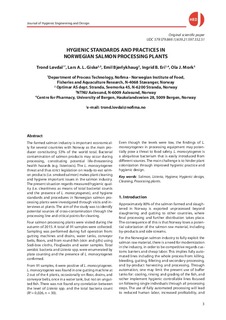| dc.contributor.author | Løvdal, Trond | |
| dc.contributor.author | Giske, Lars André Langøyli | |
| dc.contributor.author | Bjørlykhaug, Emil | |
| dc.contributor.author | Eri, Ingrid B. | |
| dc.contributor.author | Mork, Ola Jon | |
| dc.date.accessioned | 2018-01-05T07:58:03Z | |
| dc.date.available | 2018-01-05T07:58:03Z | |
| dc.date.created | 2017-12-18T15:50:26Z | |
| dc.date.issued | 2017 | |
| dc.identifier.citation | Journal of Hygienic Engineering and Design. 2017, . | nb_NO |
| dc.identifier.issn | 1857-8489 | |
| dc.identifier.uri | http://hdl.handle.net/11250/2475853 | |
| dc.description.abstract | The farmed salmon industry is important economically for several countries with Norway as the main producer constituting 53% of the world total. Bacterial contamination of salmon products may occur during processing, constituting potential life-threatening health hazards (e.g. listeriosis). The L. monocytogenes threat and thus strict legislation on ready-to-eat salmon products (i.e. smoked salmon) makes plant cleaning and hygiene important issues in the salmon industry. The present situation regards measured hygienic quality (i.e. cleanliness as means of total bacterial counts and the presence of L. monocytogenes), and hygiene standards and procedures in Norwegian salmon processing plants were investigated through visits and interviews at plants. The aim of the study was to identify potential sources of cross-contamination through the processing line and critical points for cleaning.
Four salmon processing plants were visited during the autumn of 2015. A total of 91 samples were collected. Sampling was performed during full operation from: gutting machines and drains, water tanks, conveyor belts, floors, and from round fish (skin and gills) using Sodi-box cloths, FloqSwabs and water samples. Total aerobic bacteria and Listeria spp. were enumerated by plate counting and the presence of L. monocytogenes confirmed.
From 91 samples, 6 were positive of L. monocytogenes. L. monocytogenes was found in one gutting machine at 2 out of the 4 plants, occasionally on floor, drains, and conveyor belts, once in a water tank, but not on ungutted fish. There was not found any correlation between the level of Listeria spp. and the total bacteria count (R2 = 0,026, n = 30).
Even though the levels were low, the findings of L. monocytogenes in processing equipment may potentially pose a threat to food safety. L. monocytogenes is a ubiquitous bacterium that is easily introduced from different sources. The main challenge is to hinder plant colonization through improved hygienic practice and hygienic design. | nb_NO |
| dc.language.iso | eng | nb_NO |
| dc.publisher | Consulting and Training Center KEY | nb_NO |
| dc.title | Hygienic standards and practices in Norwegian salmon Processing plants | nb_NO |
| dc.type | Journal article | nb_NO |
| dc.type | Peer reviewed | nb_NO |
| dc.description.version | publishedVersion | nb_NO |
| dc.source.pagenumber | 3-11 | nb_NO |
| dc.source.journal | Journal of Hygienic Engineering and Design | nb_NO |
| dc.identifier.cristin | 1529218 | |
| dc.relation.project | Nofima AS: 10803 | nb_NO |
| dc.relation.project | Nofima AS: 11315 | nb_NO |
| dc.relation.project | Norges forskningsråd: 245613 | nb_NO |
| dc.relation.project | Norges forskningsråd: 233689 | nb_NO |
| dc.description.localcode | © 2017. Published by Consulting and Training Center KEY. Open Access. | nb_NO |
| cristin.unitcode | 194,64,93,0 | |
| cristin.unitname | Institutt for havromsoperasjoner og byggteknikk | |
| cristin.ispublished | true | |
| cristin.fulltext | postprint | |
| cristin.fulltext | original | |
| cristin.qualitycode | 1 | |
